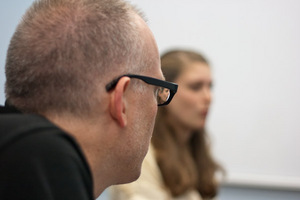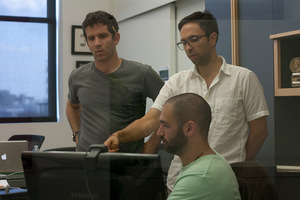While documentary films have come a long way since 2004 when Michael Moore’s Fahrenheit 9/11 became the highest-grossing documentary of all time, paving the way for feature documentaries to carry box-office clout, they still have limited theatrical release and struggle to find homes on network television. Video on demand and streaming have increased documentaries’ exposure and allowed for audiences outside of large cities and the film festival circuit to discover them, but still, it is always an uphill battle.

And, because they’re often funded through grants or the pure sweat and tears of filmmakers, partnering with companies like HBO, Showtime, ITVS, PBS or Hollywood distributors can come as a welcome financial boost for the filmmaker as well as increase a film’s audience.
But those are pretty traditional routes. An emerging avenue for documentary filmmakers to reach new audiences — and funds — is through Transmedia Storytelling. Transmedia Storytelling is the practice of telling a single story with multiple platforms and formats, often using digital tools. Often shortened to simply Transmedia, it can allow documentary filmmakers to not only reach new audiences, but also to create unique educational components to enhance their film’s message and provide ways to partner with companies and brands, which can mean welcome financial relief to lighten the burden of the high cost of filmmaking.
Cross-platform means increased audience

Take for instance, the work and advice of Antonio Kaplan, CEO and co-founder of Innovent, who recently participated in POV’s Hackathon held in Brooklyn, N.Y., last month.
Kaplan often works with documentary filmmakers. He said his company was doing Transmedia before it was a buzzword.
“For about three years I couldn’t explain to anyone what we did without it being a mouthful. Finally, Lance Weiler said, ‘You’re a Transmedia Production Company.’”
Kaplan worked with Weiler on “Pandemic 1.0”, a Transmedia project Weiler describes as an experiment in breaking down the fourth wall. While Weiler’s short film “Pandemic” premiered at Sundance in 2011, “Pandemic 1.0,” an alternate reality game, was hosted live in conjunction with the film in Park City, Utah. Weiler’s project garnered a lot of attention and showcased the possibilities cross-platforming different experiences with film can open up to audiences.
What makes for good transmedia storytelling?
Kaplan believes a Transmedia project must stand on its own. He likes to use the visualization of a pyramid to describe a documentary project integrating a Transmedia component: “One side is film and one side is technology, and the third side is marketing/fundraising. The constraints these three apply are really valuable. If you don’t understand the boundaries of the creative process and the marketing process, you’re just building tech. The same applies if you are just thinking creative, then you’re not thinking about audience engagement or the technological advancements that are there to facilitate your message, and you end up with a skewed result. Looking through this three-sided prism allows a lot of the strengths of these disciplines to shine, and that’s what Transmedia really is.”

Kaplan said initially most documentary filmmakers are confused when he begins discussions on how a Transmedia project could be funded by brands or companies. Most documentary filmmakers traditionally shy away from these forms of financing. Kaplan explained this is because they often feel they will have to make compromises on their subject matter. But in his experience, brands don’t interfere with the message and are simply looking to reach a new audience or provide good content to their own clientele. They are primarily interested in the bottom line. Making a profit and commercializing their work allows a documentary filmmaker to continue to produce more films.
Adnaan Wasey, director of POV Digital, pointed to the commercial potential he saw in some of the filmmakers’ projects produced during POV’s Hackathon. He even met afterward with some of them to help them finds ways of monetizing their projects. None of the filmmakers involved in the Hackathon were POV filmmakers, yet Wasey saw the need for this kind of event.
“We are seeing a change in the way people are consuming educational content and the way they interact with social issues,” Wasey said. “Documentaries have been a static thing, a 90-minute film or a 20-minute or 40-minute short film. If you really think about it, photos, news, and social feeds, these are all non-fiction; non-fiction powers the web, so why shouldn’t the web power non-fiction?”
The key, Kaplan said, is to fully integrate.
“If you do Transmedia well, it inherently serves as marketing, but if you try to only do marketing with it, that is inherently different. The point is to further engage audiences. Most people need a way to enter a story. If you only use the Transmedia to point people to the main element, then it feels like marketing.”
Wasey agreed that for a Transmedia project to be successful it must stand on its own as unique content.
“The world is increasingly digital, and filmmakers are having to embrace that. The conversation is often geared towards distribution, but we are talking web-based content as well. The content must live in a fundamental way and not just be about engagement or marketing. It is always challenging to get an audience member or user to want to engage in a call to action. So why limit yourself to just making a documentary when there is a potential to do so much more? People are online looking for things to do; they are inherently interested in being interactive.”
Kaplan believes the word “Transmedia” is a buzz term that while currently all the rage may soon go out of fashion. But the essence of Transmedia storytelling — the integration of digital technologies and creating cross-platform experiences to enhance content, perhaps in a documentary’s case its message — is here to stay. Documentary filmmakers already wear many hats. Partnering with a developer familiar with coding and end users’ needs will elevate a documentary Transmedia project — and just might open creative avenues the creator wouldn’t have thought of on his or her own. With Transmedia, it really does take a village.
Complete information on all the team members and demonstrations of the projects can be viewed at the POV website.
Amanda Lin Costa is a writer and producer in the film and television industry. She writes a series called “Truth in Documentary Filmmaking” and is currently producing the documentary, “The Art of Memories.”

